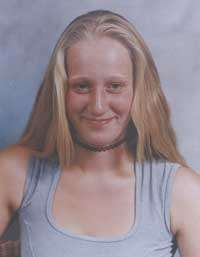Murder of Hannah Williams
| Hannah Williams | |
|---|---|
 A photograph of Hannah Williams released to the public. | |
| Born |
May 1986[1] London, England |
| Disappeared |
21 April 2001 (aged 14) South London, England |
| Body discovered |
15 March 2002 Northfleet, Kent |
The murder of Hannah Williams was an English case in which a 14-year-old schoolgirl, Hannah Williams (May 1986 – c. 21 April 2001), was murdered after going missing during a shopping trip on 21 April 2001.
The case has been cited (by British charity Missing People, formerly the National Missing Persons Helpline, among others) as an example of missing white woman syndrome. This is because Williams, a working-class girl with a history of running away from home, received comparatively far less press coverage than other missing girls of a similar age who disappeared around the same time. Namely, Danielle Jones (who disappeared in June 2001 and whose body has never been found) and Milly Dowler, both of whom fit a supposedly more wholesome image of the middle-class schoolgirl from a stable family.
Discovery of the body and conviction of the killer
Williams's body was discovered on 15 March 2002[2] in an industrial area of Northfleet, Kent, beside the Thames estuary.
Initially it was speculated that the body was that of Danielle Jones, who had been missing from East Tilbury in Essex since 18 June 2001, but it was soon firmly identified by Williams's distinctive clothing. The discovery of Williams's body overlapped with the investigation into the disappearance, and later murder, of Milly Dowler from Surrey, who vanished on 21 March 2002.
Robert Lesarian Howard,[3] a convicted sex offender who had known Williams since 1999, was arrested on 23 March 2002, eight days after her body was found. At his trial at Maidstone Crown Court in October 2003, Howard was found guilty of raping and murdering Williams, and was sentenced to life imprisonment. No recommended minimum term was reported to have been recommended by the trial judge and there have been no reports of a minimum term subsequently issued by the High Court.[2][4][5]
Contrasts in news media coverage
There was a contrast between the girls' backgrounds and a parallel disparity between the news media coverage that each received: images of Dowler, a middle-class girl from a seemingly stable family background who had never previously gone missing, were splashed on the front pages of national newspapers within days as her disappearance attracted national attention, and Danielle, similarly, fulfilled the news media's criteria for a model middle-class schoolgirl. Milly Dowler's body was finally found in September 2002, six months after she disappeared, although it was almost a decade before the conviction of her killer Levi Bellfield. Danielle Jones's body has never been found, although enough evidence was found within five months to charge her uncle Stuart Campbell with her murder, for which he was convicted in December 2002.
Hannah Williams, however, was a girl from a working-class single-parent home who had spent time in care and had a history of running away – she attracted scant coverage in the media.[6][5][7] A police spokesperson described Williams's mother as "not really press conference material" and, while Dowler and Jones continued to dominate newspaper headlines, Williams was almost immediately forgotten in the news media. The National Missing Persons Helpline noted, in commenting upon the case, that news media treating such stories would often ask for cases where the subject was female, within a particular age range and with a particular social background.[8][9]
Most of the coverage of Williams, a total of 62 articles in British newspapers, was at the time of the initial discovery of her body and resulted from the initial interest in the possibility that the body could be that of Danielle Jones. In contrast, the media coverage of the two 10-year-old girls who were victims in the Soham murders in August 2002 generated 898 articles in under two weeks.[10]
The only regular coverage was by the local newspapers The Mercury and the South London Press which covered the disappearance of Williams from two weeks after she first vanished to the day her body was found and beyond to the murder trial of her killer.
An anonymous Kent police officer was quoted in The Guardian:
"There are serious questions to be raised about the original missing persons investigation. This is very sensitive, but if Hannah Williams had been a Milly Dowler, she may not be dead now."[6]
References
- ↑ http://www.kentonline.co.uk/kent/news/northfleet-sex-killer-jailed-fo-a20407/
- 1 2 "Mum relives moment she met her daughter's killer". 23 September 2005. Retrieved 30 November 2006.
- ↑ Robert Howard – Failures need to be addressed by Irish Examiner 22 September 2005: "Robert Lesarian Howard, from Wolfhill, Co Laois, was sentenced to life in prison in Britain in 2003 for murder of a 15-year-old English schoolgirl, Hannah Williams."
- ↑ "Girl's killer serves life in jail". BBC News. 23 September 2005. Retrieved 30 November 2006.
- 1 2 McKay, Susan (25 March 2006). "Predator in the badlands". The Guardian. London: Guardian Newspapers Limited. Retrieved 16 January 2007.
- 1 2 Prasad, Raekha (28 March 2002). "Why is this the first we've heard of Hannah Williams?". The Guardian. London: Guardian Newspapers Limited. Retrieved 20 November 2006.
- ↑ Fiona Brookman (2005). Understanding Homicide. Sage Publications. p. 257. ISBN 0-7619-4755-8.
- ↑ Jeff Ferrell (2004). Cultural Criminology Unleashed. Routledge Cavendish. pp. 113–114. ISBN 1-904385-37-0.
- ↑ Nicole Martin (24 April 2002). "Why police have poured all their resources into the hunt". The Daily Telegraph. London.
- ↑ Camillo Fracassini (18 August 2002). "The Agenda: Missing". The Scotsman.